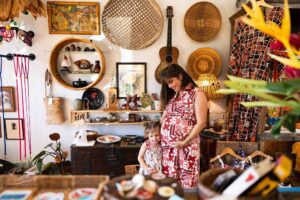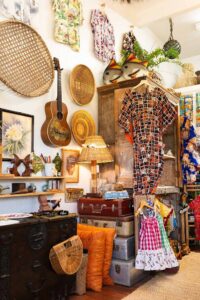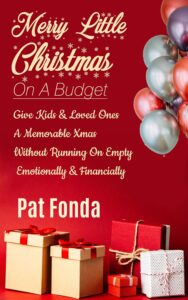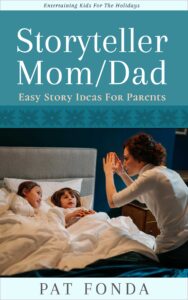









Gallery |
 West Kauaʻi, Where Locals Preserve the Island’s Soul Fonda’s Daughter (Retail)  Nestled next to Hanapēpē’s Hawaiian Congregational Church, Fonda’s Daughter co-founders Natalie Fonda and her husband Kekoa Seward have opened a Hawaiiana vintage store that feels like stepping back in time. The extensive curation put into this collection of items — from mu’umu’u to aloha shirts to old music records — is so clearly a labor of love, one can’t help but be drawn in by what Fonda describes as an “organized treasure hunt.” At Fonda’s Daughter, Fonda and Seward specialize in showcasing and preserving vintage pieces, often rescuing items that might otherwise be thrown away, ensuring that a piece of history lives on. Growing up on O‘ahu, in the windward community of Ka‘a‘awa in the 1990s, Fonda was raised with the love of all things vintage. Her father, Fulvio Fonda, moved their family to Hawai‘i from the Bay Area in her early childhood. Being raised by a vintage dealer with a passion for aloha shirts meant that as a little girl she would tag along every weekend to the Aloha Stadium swap meet, a formative experience that shaped her deep connection to vintage Hawaiiana culture and inspired the shop’s name, Fonda’s Daughter. As an adult, Fonda continues to travel to O‘ahu every Sunday, joining her father to search for exciting finds in a ritual that demonstrates the intergenerational labor of love that underlies the heart of the shop’s endeavor. Scattered around the little shop, one will find handwritten signs that designate each rack with the item’s name in ‘ōlelo Hawai‘i, a handmade touch from Seward’s mother, who can often be found lei-making out front on Hanapēpē Friday Art Nights, to imbue the space with a sense of Hawaiian identity. “Any opportunity we have to teach visitors the history and culture, it’s important,” Fonda says. “I think we have a responsibility to do that. I wasn’t born here, but I was raised here from the time I was 5-years-old and my husband’s family goes back generations. My daughter is part-Hawaiian. I believe we have a duty to teach her the history as well.” For visitors, the shop provides an opportunity to move beyond surface-level experiences of Hawai‘i. Fonda and Seward encourage tourists to immerse themselves, learn about local perspectives, and connect with the island’s true essence. For locals, it’s a nostalgic dive into our recent past, delighting local customers young and old who find beautifully maintained vintage mu‘umu‘u or a graphic T-shirt that reminds them of the one their uncle used to wear. Fonda is committed to keeping prices reasonable so locals can continue to shop hvere. “I know the history and the story that comes with a mu’u mu’u or an aloha shirt,’ she says. “Everything has a memory behind it and I think that’s most important. Sometimes I have people coming in and saying, ‘Oh I wish I had saved a bunch of my grandma’s things,’ and seeing their faces light up when they pull an item and go, ‘Oh my gosh, I see my grandma or my grandpa in this…’ They bring so many good memories with them.” 
 Christmas On A Budget: What To Do If Your Kid’s Favorite Toy Is Sold Out If you’ve seen the film Jingle All The Way with Arnold Schwarzenegger then you know that this can become an emotionally charged and very vexing problem. What you don’t know is that there are simple solutions that leave everybody cool and collected. By: WordCraft Club WEST PALM BEACH, Fla. – Nov. 10, 2024 – PRLog — Pat Fonda, author of titles like Supercommunicator Spouses, Storyteller Mom/Dad and Gaming Addiction In Children is pleased to announce an important update to her Kindle book, Merry Little Christmas On A Budget: Give Kids And Loved Ones Memorable Holidays Without Running On Empty Emotionally Or Financially. A new chapter has been added that helps parents and gift-givers, who may find themselves in the same quandary as Arnold Schwarzenegger’s character in Jingle All The Way, worm themselves out of the fix – without the toy, it has to be said; but they will enjoy the respect and admiration of their kids for being resourceful… and living up to their promises!  “It’s hard to disappoint a child when they have their heart set on something,” says Pat Fonda. “And this is where parents get ensnared. They forget that a kid’s desires are extremely malleable – the younger, the more malleable!” If you’ve been with kids 3-7 years or so in an ice-cream joint, maybe you can relate: one second she was sure she’ll take the pink scone with frothy white top, and the next few seconds she shouts out, “No; I’ll take the white scone with the frothy pink top!” Don’t take this literally – but we guess you get the point. Lean more here: https://www.patfonda.com/2024/11/merry-little-xmas-on-budget-concise.html The thing is, according to Pat Fonda: “It’s us the adults who make Christmas hard, not the other way around.” This new chapter will show parents and gift-givers that they have options – seven to be exact – how to find wiggle-room without hurting your child’s feelings, or ending the kid’s expectations; or their respect for you; or their trust that you’ll make good on your promises! With the Christmas shopping frenzy just beginning to heat up parents and gift-givers can save money – and still give their kids great gifts and great holidays – without running on empty emotionally or financially. Pat Fonda offers a full range of solutions to help you raise happy, resilient kids and robust families over at her website: https://www.patfonda.com Contact
20 years of the School for Curatorial Studies VeniceInterview with Aurora Fonda of the School for Curatorial Studies Venice  More than a school for curators, it is now a cultural institution frequented by young people from all over the world who want to participate in the art of exhibiting art. He turns twenty years old School for Curatorial Studies Venice founded by Aurora Fonda and Sandro Pignotti in 2004 in Venice with the aim of creating an open laboratory for the visual arts and for all professions related to contemporary art. The Summer School has also been active since 2015, bringing together participants from all over the world. We retraced 20 years of training with Aurora Fonda in this interview. Since 2003 you have been the director of the AplusA gallery in Venice, and only a year later you had the idea of founding a curators’ school from scratch. Lack of available professional figures, or desire to implement a new teaching of contemporary art? Offer them an opportunity to learn and have direct discussion with the hot topics of curation, exhibition design, communication…  Where did you start? What aspects of curating do you pay most attention to, what are your privileged experiences? So it can be said that the first supporters of the school were the artists themselves?  Has the demand from foreign students also grown over time? Another strong point of the school is that a lot of theory is studied… but at a certain point it must be put into practice (continued on webpage) Also see: https://www.linkedin.com/in/aurora-fonda-20965821 https://www.curatorialstudiesveniceonline.com/the-tutors-i-docenti/aurora-fonda
Bob and Jen take a class at Nuesole Glassworksby Bob Herzog and Jen Dalton, WKRCMon, May 6th 2024 CINCINNATI (WKRC) – We like to keep things classy but today we are going to keep things glassy. “One of the first things I talk to people blowing glass is that you will learn a lot of patience. It’s going to be really frustrating, those pieces often hit the ground,” said Ali Fonda. Fonda is just one of the teachers at Nuesole Glassworks. She says it can take years to master the art of glass blowing but no need to worry, if you come in as a beginner, she has you covered. “We do all of the really complicated things until you really come and do it for a while.”
We are going to be making something called a witches ball, or a fairy orb. With that we were ready to get to work, and of course safety first. The gas powered furnaces clock in at more than a thousand degrees Fahrenheit. We put on our protective equipment while Ali gathered a ball of molten glass on a long metal pipe. The next step in this process is to create a perfect sphere.
And while that was happening, Ali and Jen used a wooden tool that was soaked in cool water to create the sphere. This is where the fun really started. With a sharp tool we stabbed holes in our sun catcher. Ali told us to trust the process and that this would make the final design extra special. Not going to lie, this was a little violent. After the stabbing was done, Ali took a blow torch to the orb and with one crack, our creation was freed from the metal pole and ready to go into a kiln where it would harden.
Sisters discover letters to their father from his friend killed during WWIIBy Elizabeth Pritchett, Fox News
|